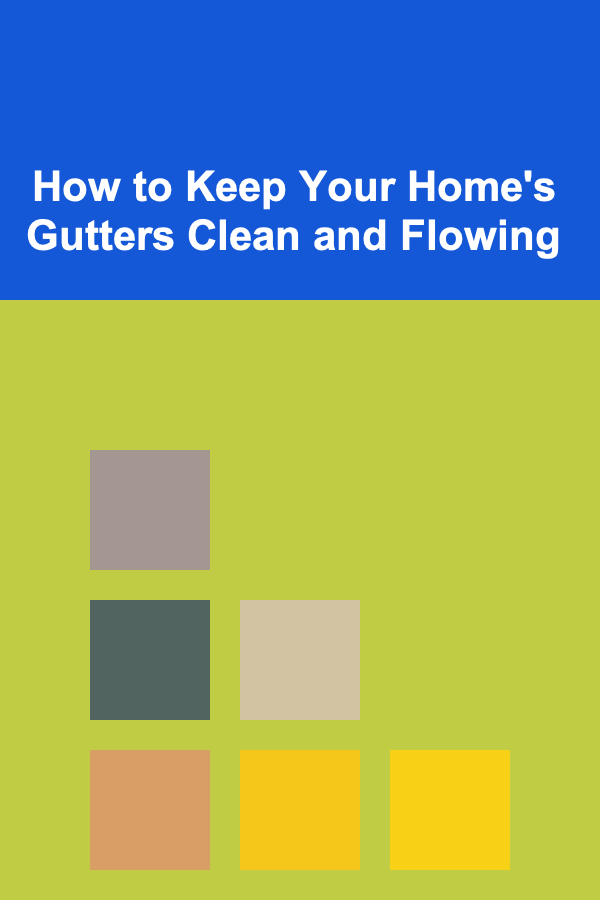
How to Keep Your Home's Chimney Clean and Safe
ebook include PDF & Audio bundle (Micro Guide)
$12.99$11.99
Limited Time Offer! Order within the next:

A well-maintained chimney is crucial for the safe operation of a fireplace or stove. Over time, chimneys can accumulate soot, creosote, and other debris that can lead to fires, blockages, and unpleasant odors. Regular chimney cleaning and maintenance not only keep your fireplace working efficiently but also ensure the safety of your home and family.
In this article, we will explore the importance of keeping your chimney clean, signs that your chimney needs cleaning, how to clean it, and tips for maintaining chimney safety throughout the year.
Why Chimney Maintenance is Important
A clean chimney plays a significant role in the safety of your home. When a chimney is not properly maintained, dangerous substances like creosote can accumulate inside, which is highly flammable. Creosote is a byproduct of burning wood and can quickly build up in the chimney flue. If it ignites, it can lead to a chimney fire, which is not only destructive but can also spread to the rest of the home.
In addition to preventing fires, regular chimney cleaning ensures:
- Efficient Heating: A clean chimney allows smoke and gases to exit your home quickly, enabling your fireplace or stove to operate efficiently.
- Odor Removal: A dirty chimney can result in unpleasant smells, especially during the warmer months when the chimney is not in use. Cleaning eliminates these odors and promotes better indoor air quality.
- Pest Prevention: A chimney that is not maintained can attract animals like birds, squirrels, and raccoons. Cleaning ensures that there are no blockages or nests that could cause problems.
- Prevent Carbon Monoxide Poisoning: Carbon monoxide (CO) is a colorless, odorless gas that can be deadly if it builds up inside the home. A clean chimney allows for proper ventilation of exhaust gases, reducing the risk of CO buildup.
Signs That Your Chimney Needs Cleaning
Before diving into how to clean your chimney, it's essential to know when it needs cleaning. Some of the most common signs that your chimney requires attention include:
1. Visible Creosote Buildup
Creosote buildup is the most significant indicator that your chimney needs cleaning. Creosote is a tar-like substance that forms when wood is burned. It coats the interior of the chimney and can build up over time. If you notice a black, shiny, or sticky substance in your chimney, it's likely creosote. If it appears as a thick layer, cleaning should be a priority.
2. Smoky Odors
If your chimney has a persistent smoky smell, even when it's not in use, this could indicate a blockage or creosote buildup. The smell may become stronger when the fireplace is lit, as trapped smoke has nowhere to go but back into the room.
3. Poor Draft
If you notice that smoke is not venting properly when using your fireplace or stove, this may be due to a blockage or buildup in the chimney. A poor draft could cause the smoke to enter your living space instead of venting outside, posing health hazards.
4. Soot or Ash on the Fireplace Floor
After using your fireplace, you may notice black soot or ash buildup on the floor near the hearth. If there is an excessive amount, this is a sign that the chimney has not been properly venting, and it may require cleaning.
5. Animal or Bird Nests
Animals, such as birds, squirrels, and raccoons, often seek shelter in chimneys. If you hear unusual sounds coming from the chimney or see signs of nesting materials, such as twigs or leaves, it's essential to clean the chimney and remove any pests.
6. Cracked or Damaged Chimney Lining
A damaged chimney lining can increase the risk of fire and carbon monoxide buildup. If you notice any cracks or gaps in the lining, it's important to address them immediately. A professional inspection can assess whether cleaning or repairs are necessary.
How to Clean Your Chimney
Cleaning your chimney requires a few essential tools, including chimney brushes, rods, drop cloths, and a shop vacuum to clean up any soot and debris. While chimney cleaning can be done by homeowners, it's often best left to professionals to ensure thorough cleaning and safety.
Step 1: Gather Necessary Tools and Equipment
Before starting, make sure you have the proper tools:
- Chimney Brushes: Chimney brushes come in various sizes and are designed to fit the dimensions of your chimney flue. The brush should be made of durable, flexible material like steel or nylon bristles.
- Extension Rods: These are used to extend the reach of the chimney brush. They can be added to the brush as needed to reach the full length of the chimney.
- Drop Cloths: Use drop cloths to cover the surrounding area of your fireplace to catch debris and soot that falls during cleaning.
- Shop Vacuum: A shop vacuum is an essential tool to help clean up soot and dust after brushing the chimney.
- Safety Gear: Wear gloves, goggles, and a dust mask to protect yourself from soot and debris during the cleaning process.
Step 2: Prepare the Fireplace and Chimney
Before you begin cleaning, take a few preparatory steps:
- Ensure the Fireplace Is Cold: Never attempt to clean a chimney while the fireplace is still hot. Wait at least 24 hours after the last fire before cleaning.
- Cover the Area: Lay down drop cloths or plastic sheets to protect the floor and furniture from soot.
- Inspect the Chimney: Check the chimney for visible damage or obstructions. This may require using a flashlight to inspect the flue from the bottom or top.
Step 3: Clean the Chimney Flue
You can clean the chimney in two ways: from the top (via the roof) or from the bottom (inside the house). For most homeowners, cleaning from the bottom is the safest and easiest method.
- Attach the Brush to the Extension Rods: Secure the chimney brush to the extension rods, making sure it is tightly fastened.
- Insert the Brush into the Chimney: Begin at the bottom of the chimney (where the fireplace is located) and insert the brush into the flue. Move the brush up and down to loosen soot and creosote. Work your way up, extending the rods as necessary.
- Scrub the Entire Length: Continue to scrub the interior of the chimney until the entire length has been thoroughly cleaned. Be sure to pay extra attention to areas with heavy creosote buildup.
Step 4: Clean the Fireplace
While the chimney is being cleaned, take the time to clean the fireplace itself.
- Remove Ashes and Debris: Use a small shovel or broom to remove ashes from the bottom of the fireplace. Dispose of them safely in a metal container.
- Clean the Hearth: Wipe down the hearth with a damp cloth to remove soot and dirt.
- Check the Damper: Inspect the damper to ensure it opens and closes properly. Clean any soot buildup around the damper with a damp cloth.
Step 5: Inspect the Chimney Liner and Cap
Once the chimney is cleaned, inspect the chimney liner for any damage, cracks, or signs of wear. If you notice any problems, consult a professional chimney repair service to address them.
Check the chimney cap for blockages, leaves, or debris. A functional chimney cap helps keep animals and rain out of the chimney.
Step 6: Dispose of the Debris
After you finish cleaning, dispose of the soot and creosote properly. You can use a shop vacuum to clean up the debris, making sure to empty the vacuum's contents in a fireproof container.
Chimney Maintenance Tips
Once your chimney is clean, it's important to maintain it properly to ensure safe operation. Regular maintenance will help prevent issues like creosote buildup, blockages, and chimney damage.
1. Schedule Annual Inspections
Even if you clean your chimney yourself, it's essential to have it professionally inspected at least once a year. A certified chimney sweep can identify any underlying issues, such as cracks in the flue or signs of water damage.
2. Burn Only Seasoned Wood
Burning wet or green wood produces more smoke and creosote buildup. Always use seasoned hardwood, which burns cleaner and produces less creosote. Store firewood properly to ensure it remains dry.
3. Use Your Fireplace Regularly
Using your fireplace regularly can help reduce the accumulation of creosote. When you allow a fire to burn out completely, you minimize the moisture and buildup in the chimney.
4. Install a Chimney Cap
A chimney cap prevents debris, animals, and rain from entering your chimney. It also helps improve ventilation and can reduce downdrafts. Make sure your chimney cap is in good condition and free from obstructions.
5. Keep the Area Around the Fireplace Clean
Ensure that the area around your fireplace is free from flammable materials, such as furniture, curtains, and rugs. These can easily catch fire if they come into contact with sparks from the fire.
Conclusion
A clean and well-maintained chimney is essential for the safety and efficiency of your fireplace or stove. Regular cleaning helps prevent the risk of fires, carbon monoxide poisoning, and other hazards while improving the overall function of your heating system.
By understanding the importance of chimney maintenance and following the proper cleaning techniques, you can ensure your chimney remains in good working condition and keeps your home safe for years to come. If you're unsure about cleaning or inspecting your chimney yourself, don't hesitate to consult a professional chimney sweep for help.
Reading More From Our Other Websites
- [Beachcombing Tip 101] Best Beachcombing Gear for Beginners: Essential Tools & Equipment for Finding Shells, Sea Glass & More
- [Organization Tip 101] How to Create a Wishlist for Beauty Products You Want
- [Home Family Activity 101] How to Set Up a Family Craft Corner on a Budget
- [Personal Care Tips 101] How to Use a Razor for Shaving in Sensitive Areas Safely
- [Personal Care Tips 101] How to Use Facial Cleanser to Treat Skin Irritations and Redness
- [Home Party Planning 101] How to Choose the Best Home Party Venue When You Have Limited Space
- [Home Pet Care 101] How to Stop a Cat from Scratching Furniture: Effective Training Tips
- [Organization Tip 101] What Tips Can Help You Create an Organized Family Command Center?
- [Organization Tip 101] How to Use Lighting to Enhance Your Home's Ambiance
- [Sewing Tip 101] Must-Make Baby Essentials for New Parents Who Love to Sew

How to Build a Checklist for Website Design Optimization
Read More
How to Build a Checklist for Writing a Resume for a Career Change
Read More
How to Host a Memorable Dinner Party at Home
Read More
How to Implement Kitchen Storage Ideas That Save Space and Time
Read More
How to Keep Your Home's Gutters Clean and Flowing
Read More
10 Tips for Avoiding Common Investing Mistakes
Read MoreOther Products

How to Build a Checklist for Website Design Optimization
Read More
How to Build a Checklist for Writing a Resume for a Career Change
Read More
How to Host a Memorable Dinner Party at Home
Read More
How to Implement Kitchen Storage Ideas That Save Space and Time
Read More
How to Keep Your Home's Gutters Clean and Flowing
Read More